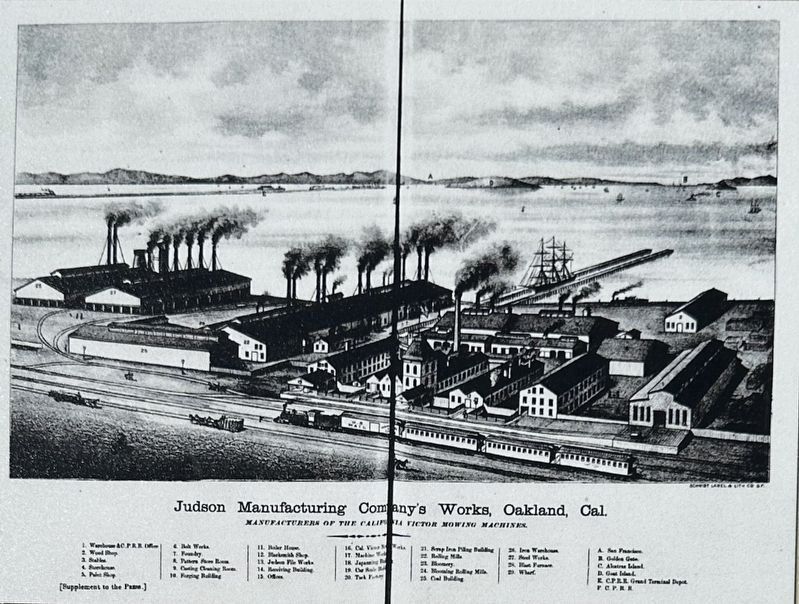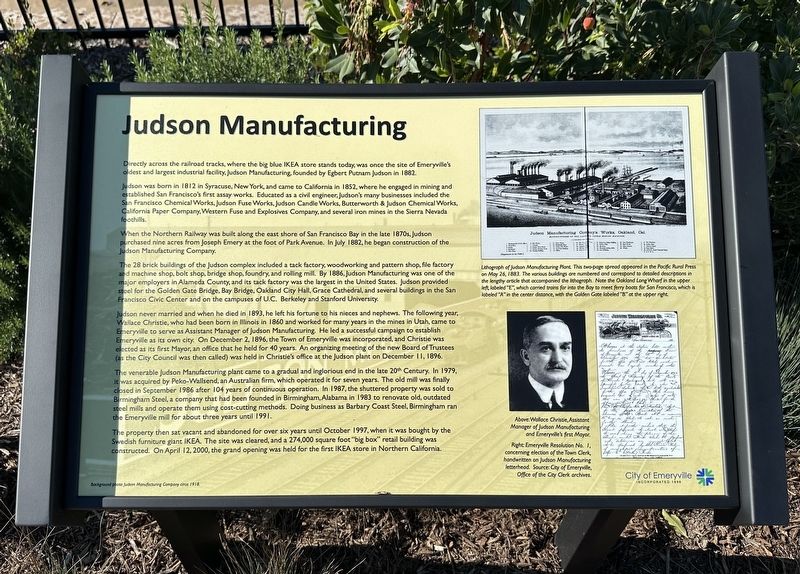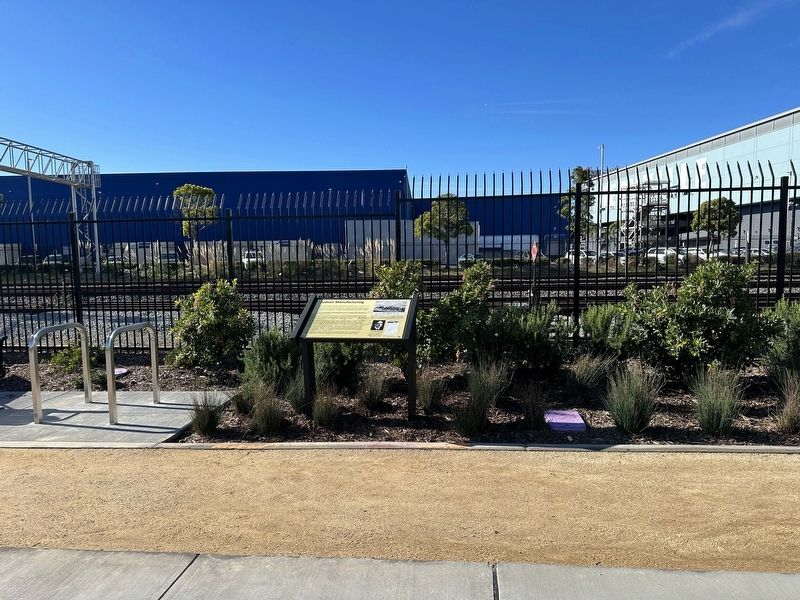Emeryville in Alameda County, California — The American West (Pacific Coastal)
Judson Manufacturing
Directly across the railroad tracks, where the big blue IKEA store stands today, was once the site of Emeryville's oldest and largest industrial facility, Judson Manufacturing, founded by Egbert Putnam Judson in 1882.
Judson was born in 1812 in Syracuse, New York, and came to California in 1852, where he engaged in mining and established San Francisco's first assay works. Educated as a civil engineer, Judson's many businesses included the San Francisco Chemical Works, Judson Fuse Works, Judson Candle Works, Butterworth & Judson Chemical Works, California Paper Company, Western Fuse and Explosives Company, and several iron mines in the Sierra Nevada foothills.
When the Northern Railway was built along the east shore of San Francisco Bay in the late 1870s, Judson purchased nine acres from Joseph Emery at the foot of Park Avenue. In July 1882, he began construction of the Judson Manufacturing Company.
The 28 brick buildings of the Judson complex included a tack factory, woodworking and pattern shop, file factory and machine shop, bolt shop, bridge shop, foundry, and rolling mill. By 1886, Judson Manufacturing was one of the major employers in Alameda County, and its tack factory was the largest in the United States. Judson provided steel for the Golden Gate Bridge, Bay Bridge, Oakland City Hall, Grace Cathedral, and several buildings in the San Francisco Civic Center and on the campuses of U.C. Berkeley and Stanford University.
Judson never married and when he died in 1893, he left his fortune to his nieces and nephews. The following year, Wallace Christie, who had been born in Illinois in 1860 and worked for many years in the mines in Utah, came to Emeryville to serve as Assistant Manager of Judson Manufacturing. He led a successful campaign to establish Emeryville as its own city. On December 2, 1896, the Town of Emeryville was incorporated, and Christie was elected as its first Mayor, an office that he held for 40 years. An organizing meeting of the new Board of Trustees (as the City Council was then called) was held in Christie's office at the Judson plant on December 11, 1896.
The venerable Judson Manufacturing plant came to a gradual and inglorious end in the late 20th Century. In 1979, it was acquired by Peko-Wallsend, an Australian firm, which operated it for seven years. The old mill was finally closed in September 1986 after 104 years of continuous operation. In 1987, the shuttered property was sold to Birmingham Steel, a company that had been founded in Birmingham, Alabama in 1983 to renovate old, outdated steel mills and operate them using cost-cutting methods. Doing business as Barbary Coast Steel, Birmingham ran the Emeryville mill for about three years until 1991.
The property then sat vacant and abandoned for over six years until October 1997, when it was bought by the Swedish furniture giant IKEA. The site was cleared, and a 274,000 square foot "big box" retail building was constructed. On April 12, 2000, the grand opening was held for the first IKEA store in Northern California.
Erected 2023 by City of Emeryville.
Topics. This historical marker is listed in this topic list: Industry & Commerce. A significant historical date for this entry is April 12, 2000.
Location. 37° 49.929′ N, 122° 17.441′ W. Marker is in Emeryville, California, in Alameda County. Marker can be reached from Halleck Street north of Sherwin Avenue. Touch for map. Marker is in this post office area: Emeryville CA 94608, United States of America. Touch for directions.
Other nearby markers. At least 8 other markers are within walking distance of this marker. Xučyun Park (Huchiun Park) (a few steps from this marker); Welcome to the Emeryville Greenway (within shouting distance of this marker); Sherwin-Williams (within shouting distance of this marker); Two Emeryville Pioneers (within shouting distance of this marker); Emeryville’s Mexican Heritage (about 600 feet away, measured in a direct line); Emeryville’s Horse Racetrack (approx. 0.2 miles away); Northern Railway (approx. 0.2 miles away); PCR Park (approx. ¼ mile away). Touch for a list and map of all markers in Emeryville.

3. Marker detail: Lithograph of Judson Manufacturing Plant and caption
This two-page spread appeared in the Pacific Rural Press on May 26, 1883. The various buildings are numbered and correspond to detailed descriptions in the lengthy article that accompanied the lithograph. Note the Oakland Long Wharf in the upper left, labeled "E", which carried trains far into the Bay to meet ferry boats for San Francisco, which is labeled "A" in the center distance, with the Golden Gate labeled "B" at the upper right.
More about this marker. The marker is located on the west side of Huchiun Park, next to the Emeryville Greenway.
Also see . . . The History of Judson Iron Works (Emeryville Historical Society).
Excerpt: In 1882, he founded the Judson Iron Works, an outgrowth of a tack and horseshoe nail manufacturing plant. Judson’s business associates included Anthony Chabot, water baron and father of hydraulic mining, who had also come to the coast via the Mother Lode. The original ironworks occupied a nine-acre site ideally situated between the railroad tracks and the Bay. In its cluster of brick buildings, Victor mowers and shipping crates were made, in addition to tacks and nails.(Submitted on January 6, 2024.)
By 1885, the plant consisted of 28 buildings, including a new brick warehouse, a bewildering labyrinth of shops, and some enormous shears for cutting up scrap iron. Judson’s annual payroll was $180,000. and 500 workers were employed...
Credits. This page was last revised on January 6, 2024. It was originally submitted on January 6, 2024, by Andrew Ruppenstein of Lamorinda, California. This page has been viewed 76 times since then. Photos: 1, 2, 3. submitted on January 6, 2024, by Andrew Ruppenstein of Lamorinda, California.

